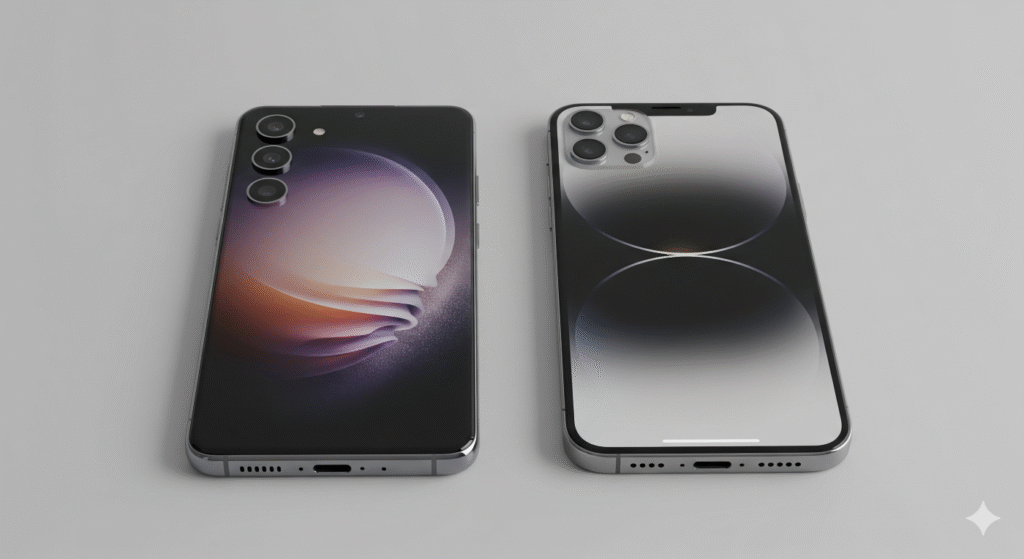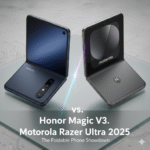The 2025 Smartphone landscape has reached new heights of innovation. Samsung Galaxy S25 Ultra vs. iPhone 16 Pro Max battle steals the spotlight. Samsung features a powerhouse of AI-driven innovation and camera versatility, while Apple shines with seamless ecosystem integration and cinematic video prowess.
Both the 2025 flagships deliver top-tier performance, but they cater to different priorities. After hands-on testing, we’ve broken down their strengths to help you decide: Which smartphone deserves your hard-earned money?
Design and Build
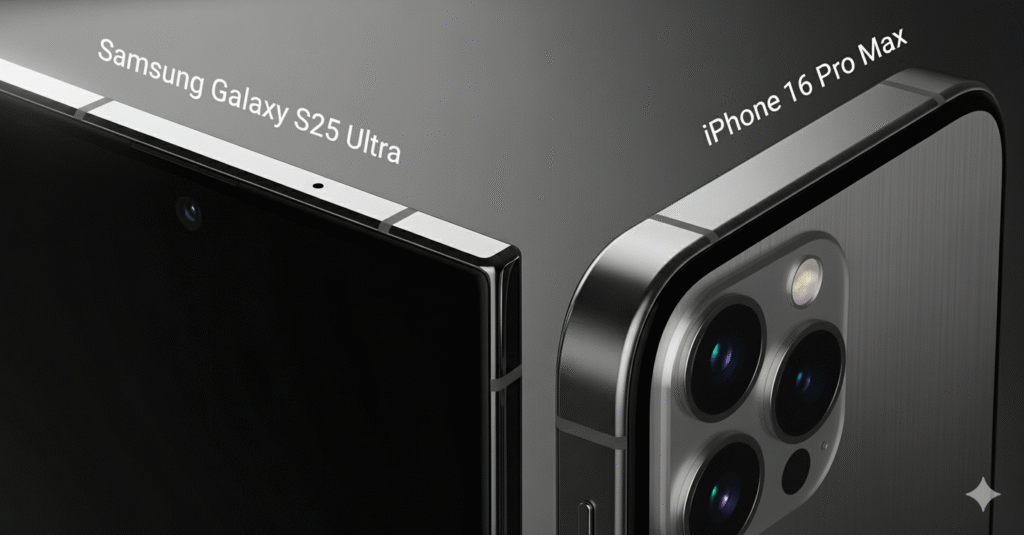
Close-up of Galaxy S25 Ultra flat design vs iPhone 16 Pro Max titanium body
Samsung Galaxy S25 Ultra: Sleek and Modern
The Galaxy S25 Ultra rocks a refined look with a sleek titanium frame, flat edges, and a comfortable 218g weight. At 8.2mm thick, it feels premium yet easy to hold. The built-in S Pen, tucked neatly into its slot, remains a standout feature, perfect for notes, sketches, or precise edits. Available in seven vibrant titanium colors like Titanium Black and Jadegreen, Samsung’s design blends modern style with practical flair.
iPhone 16 Pro Max: Refined Elegance
The iPhone 16 Pro Max nails Apple’s signature aesthetic with a titanium body and slightly rounded edges that feel great in hand. The Dynamic Island is now a seamless part of the experience, while new buttons—like the Action Button and Camera Control—add functionality without clutter. Thinner bezels make the screen feel more immersive, elevating the premium vibe.
Durability Face-Off
Both phones meet 2025 smartphone durability standards with flying colors:
• Samsung: Gorilla Glass Armor 2 with anti-reflective coating reduces glare and smudges. IP68 rating protects against 1.5m water submersion for 30 minutes.
• iPhone: Ceramic Shield (front and back) is 2x tougher than standard glass, resisting scratches in real-world use. Also IP68-rated.
In drop tests, both survived 1-meter falls with minimal damage, proving they’re built to last. Samsung’s anti-reflective screen stays cleaner, while Apple’s Ceramic Shield excels at scratch resistance.
Display Showdown
Screen Size and Brightness
The display is where Samsung truly flexes its technological muscle.
The S25 Ultra boasts a 6.9-inch AMOLED display with a crisp 3120×1440 resolution and a 120Hz adaptive refresh rate.
More impressive is the peak brightness of 2,600 nits, making outdoor visibility exceptional even in direct sunlight. Samsung’s anti-reflective Corning Gorilla Glass Armor 2 significantly reduces glare, creating an almost paper-like viewing experience that’s easier on the eyes during extended use.
On the othe hand, the iPhone 16 Pro Max matches with a 6.9-inch Super Retina XDR display at 2796×1290 resolution, also with a 120Hz ProMotion refresh rate. While its 1,553-nit brightness trails Samsung, Apple’s color calibration delivers incredibly natural tones, perfect for media lovers.
Key Differences
• Brightness: Samsung’s display wins for outdoor visibility with higher nits.
• Color Accuracy: iPhone excels in Dolby Vision playback with lifelike colors.
• HDR: Samsung supports HDR10+ with brighter highlights; iPhone’s Dolby Vision feels more cinematic.
• Refresh Rate: Both use LTPO tech for smooth, power-efficient scrolling.
For display comparison Samsung vs. iPhone, Samsung takes the lead for brightness and outdoor use, while Apple’s color accuracy shines for movies and photos.
Camera Battle
Photography Powerhouse
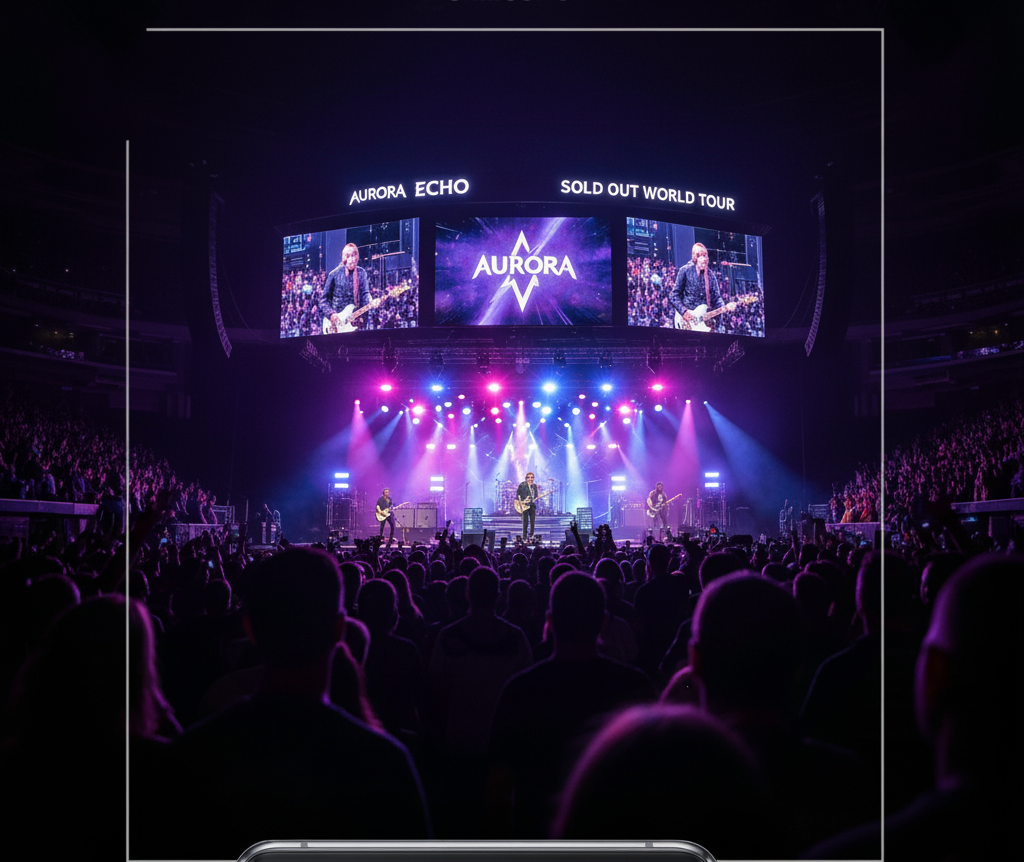
Snapping photos at a concert, the S25 Ultra’s Nightography preserved more detail in dim lighting.
Samsung Galaxy S25 Ultra:
Hardware: A quad-camera setup shines: 200MP main (f/1.7), 50MP ultrawide (f/2.2), 10MP telephoto (3x optical, f/2.4), and 50MP telephoto (5x optical, f/3.4). The 12MP front camera is solid for selfies.
Software & Features: The real magic happens in software. Samsung’s “Nightography” has matured significantly, delivering clean low-light images that rival dedicated cameras.
The enhanced generative AI editing features, particularly the ability to remove shadows and unwanted objects seamlessly, transform photo editing from chore to creative opportunity. These AI tools work locally on the device, ensuring privacy while delivering professional-grade results.
Performance: In my tests, the 200MP sensor captured sharp details in daylight, and the 5x zoom outperformed the iPhone in distant shots (e.g., wildlife photography).
Video Recording
iPhone 16 Pro Max
Hardware: Apple’s triple-camera system might seem modest on paper—48MP main, 48MP ultrawide, and 12MP telephoto with 5x optical zoom—but the integration with Apple’s computational photography is extraordinary.
The LiDAR Scanner enhances autofocus speed and enables advanced AR applications that feel genuinely useful rather than gimmicky.
Where Apple truly shines is in video recording. The iPhone 16 Pro Max supports ProRes video at 4K 120fps and Log recording, and Action Mode stabilization that makes handheld footage look professionally shot.
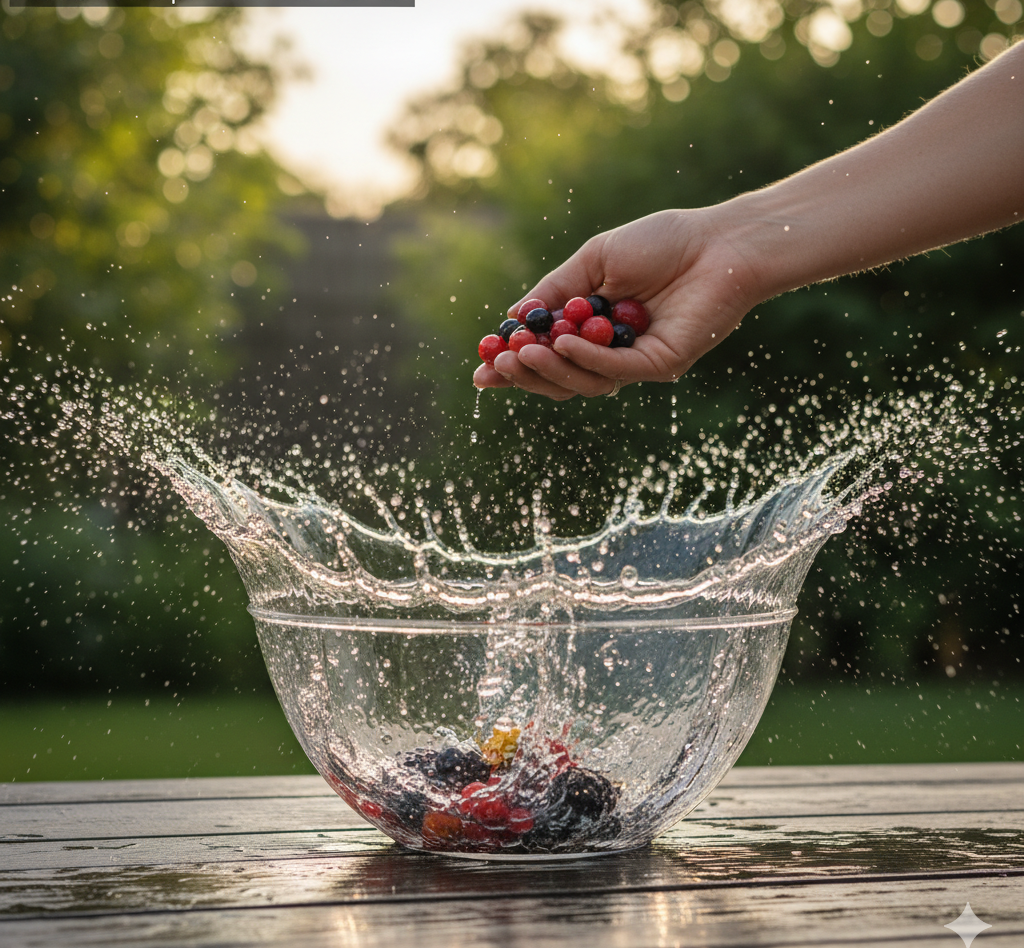
ProRes video at 4K 120fps
The new Camera Control button isn’t just a shutter release—it’s a touch-sensitive interface that allows quick adjustment of exposure, zoom, and focus without touching the screen.
Features: Apple Intelligence integration brings smart scene recognition and automatic photo organization that feels intuitive rather than intrusive. The camera app learns your preferences and suggests optimal settings based on shooting conditions.
Performance: The iPhone’s colors are more natural in daylight, and its video stabilization is unmatched. Night mode shots are warmer but slightly less detailed than the S25 Ultra’s.
Head-to-Head Verdict
For photography enthusiasts who love to zoom and experiment with AI editing, the Galaxy S25 Ultra is unbeatable. Its camera system rewards users who want maximum control and creative possibilities.
The iPhone 16 Pro Max, however, excels for users who want consistently excellent results with minimal effort, especially for video content. If you’re creating content for social media or professional video work, Apple’s ecosystem advantages become particularly compelling.
Performance and Gaming
Chipset & Benchmarks
The Snapdragon 8 Elite vs. A18 Pro battle highlights distinct strengths:
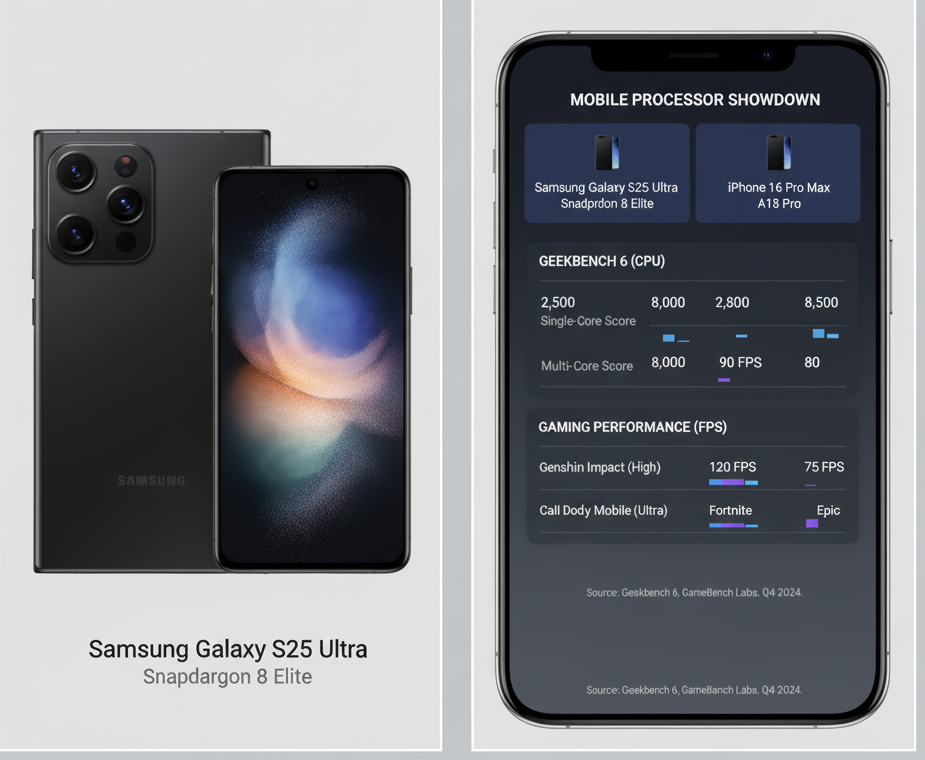
Samsung’s processor delivers a 21% multi-core boost and 38% GPU improvement over the iPhone in synthetic benchmarks like Geekbench scores and 3DMark Wild Life Extreme tests.
The A18 Pro chip leads in single-core tasks by 15%, creating snappier performance for iOS-optimized applications.
The smartphone performance 2025 comparison shows Samsung excelling in raw computational power while Apple focuses on efficiency and optimization.
Multitasking and RAM
The Galaxy S25 Ultra offers 16GB RAM Samsung configurations (12GB/16GB options), ensuring seamless multitasking even with intensive applications like Adobe Premiere Rush. This substantial memory advantage becomes apparent when running multiple demanding apps simultaneously.
The iPhone 16 Pro Max’s 8GB RAM benefits from superior iPhone optimization, handling most tasks smoothly despite the lower specification. iOS’s tight hardware-software integration maximizes efficiency, though heavy multitasking on flagship phones shows Samsung’s advantage.
Gaming Experience
For the best gaming phone 2025 title, both devices shine with different approaches:
The S25 Ultra’s higher RAM and superior GPU power deliver exceptional FPS performance in demanding titles like Genshin Impact without thermal throttling.
Likewise, the iPhone 16 Pro Max prioritizes sustained performance with superior cooling and consistent frame rates. Gaming benchmarks Samsung vs iPhone reveal Samsung’s raw power advantage, while Apple maintains smoother long-term gaming sessions with better thermal management.
Battery and Charging
Battery Life in Real Use
iPhone 16 Pro Max battery life slightly edges out Samsung with 17 hours and 35 minutes in mixed-use testing, compared to the Galaxy S25 Ultra endurance test result of 17 hours and 14 minutes. Both devices easily handle full-day usage with intensive tasks.
The smartphone battery 2025 performance benefits from different approaches: Samsung’s 5,000mAh capacity versus Apple’s superior iOS optimization of the 4,685mAh battery. Real-world usage shows minimal practical difference between the two devices.
Charging Speeds (Wired vs Wireless)
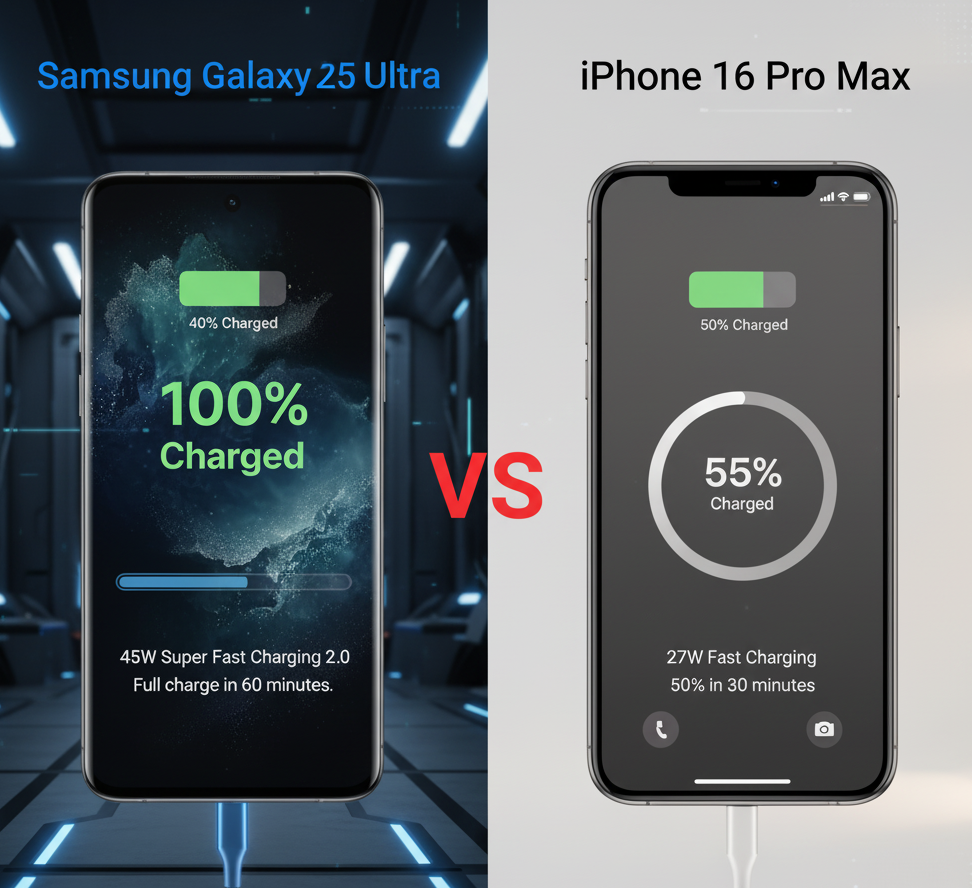
Samsung dominates in 45W fast charging Samsung technology, reaching 65% capacity in 30 minutes compared to the iPhone’s 50% in the same timeframe with 25W charging. This significant advantage benefits busy professionals who need rapid power replenishment.
For wireless charging 2025, both devices support 15W speeds, though the MagSafe charging iPhone 16 Pro Max system offers superior accessory integration. Samsung provides 15W wireless charging with compatible pads, making this category largely preference-dependent.
Software and Ecosystem
Samsung: One UI 7 and Android 15
One UI 7 on Android 15 feels polished, blending customization with practical features. Galaxy AI powers real-time call translation, smart photo editing, and more, all processed locally for privacy. The S Pen enhances productivity with precise editing and remote camera control. Samsung promises seven years of updates, ensuring longevity.
iPhone: iOS 18 and Apple Intelligence
iOS 18 brings Apple’s biggest software leap yet, with Apple Intelligence offering smart suggestions, enhanced Siri, and intuitive photo organization. Most features run on-device for privacy. With 5+ years of updates, iPhone stays fresh for years. The experience is streamlined but less customizable than Samsung’s.
Ecosystem Integration
The Samsung ecosystem provides excellent cross-device compatibility, particularly with Windows systems through Samsung DeX and seamless file sharing. Galaxy Buds, Galaxy Watch, and other Samsung accessories create a cohesive Android ecosystem experience.
The Apple ecosystem remains unmatched for users invested in Apple devices. Handoff between devices, Universal Clipboard, AirDrop, and Continuity Camera create seamless workflows that are difficult to replicate with other platforms. This ecosystem integration often becomes the deciding factor for existing Apple users.
Pricing and Value
Samsung Galaxy S25 Ultra Pricing
The Galaxy S25 Ultra price USA starts at:
- 256GB: $1,299
- 512GB: $1,419
- 1TB: $1,659
Trade-in deals and Samsung flagship 2025 cost promotions frequently reduce the effective price to around $1,060. Samsung’s storage upgrade deals, such as 512GB for minimal additional cost, provide excellent value for power users requiring substantial storage capacity.
iPhone 16 Pro Max Pricing
The iPhone 16 Pro Max price USA begins at:
- 256GB: $1,199
- 512GB: $1,399
- 1TB: $1,599
The Apple flagship 2025 cost advantage includes superior resale value, with iPhones typically retaining value better than Android devices over three-year periods. Apple’s trade-in program offers competitive valuations for existing devices.
Which Flagship Offers Better Value?
The best value flagship 2025 question depends on individual priorities. Samsung provides more features, higher RAM configurations, faster charging, and the unique S Pen functionality at a higher initial cost but with frequent promotional pricing.
Apple offers lower entry pricing, superior long-term value retention, and seamless ecosystem integration. For the should you buy iPhone or Samsung 2025 decision, consider your existing device ecosystem, required features, and long-term ownership plans.
Frequently Asked Questions
Which phone has the better camera in 2025?
The best smartphone camera 2025 title depends on photography priorities. The Samsung vs iPhone camera comparison shows Samsung excelling in zoom capabilities (100x vs 25x), low-light detail, and AI editing features. iPhone dominates video recording quality, color accuracy, and consistent results across all shooting conditions.
For photography enthusiasts seeking maximum versatility and zoom range, choose Samsung. For content creators prioritizing video quality and consistent results, select iPhone.
Which is the best phone for gaming in 2025?
The best gaming smartphone 2025 comparison favors different aspects. Galaxy S25 Ultra gaming benefits from 16GB RAM, superior GPU performance, and higher benchmark scores in demanding titles. iPhone 16 Pro Max gaming excels in sustained performance, better thermal management, and superior game optimization.
Choose Samsung for maximum performance in resource-intensive games. Select iPhone for consistent frame rates and longer gaming sessions without thermal throttling.
Which smartphone has longer battery life?
The iPhone vs Samsung battery life 2025 comparison shows minimal practical differences. iPhone 16 Pro Max provides slightly longer endurance (17:35 vs 17:14 hours) due to superior iOS optimization. However, Samsung’s 45W fast charging significantly reduces charging time, making it the longest lasting phone 2025 for users prioritizing quick power replenishment.
Both devices easily handle full-day usage with intensive tasks, making charging speed more relevant than raw battery life differences.
Summary Comparison
| Feature | Galaxy S25 Ultra | iPhone 16 Pro Max |
|---|---|---|
| Display | 6.8″ AMOLED, 2600 nits | 6.9″ OLED, 2000 nits |
| Processor | Snapdragon 8 Elite | A18 Pro |
| Main Camera | 200MP | 48MP |
| Zoom | 100x Space Zoom | 5x Optical |
| Battery | 5,000mAh, 45W charging | 4,685mAh, slower charging |
| Starting Price | $1,299 | $1,199 |
| Key Advantage | Versatility, S Pen | Ecosystem, Video |
Choose the Samsung Galaxy S25 Ultra if you:
- Want maximum camera versatility with 100x zoom
- Value customization and S Pen functionality
- Need fast 45W charging and maximum screen brightness
- Work in mixed-platform environments (Windows/Android)
- Prefer higher RAM configurations and storage options
- Enjoy personalizing your device experience
Choose the iPhone 16 Pro Max if you:
- Are invested in the Apple ecosystem
- Prioritize video recording and content creation
- Value consistent long-term software support
- Prefer streamlined, curated user experiences
- Need superior app optimization and ecosystem integration
- Want natural color reproduction for media consumption
Both devices excel in their respective strengths, serving their intended audiences exceptionally well.
Consider your current ecosystem, usage patterns, and personal preferences when making this significant investment decision.
